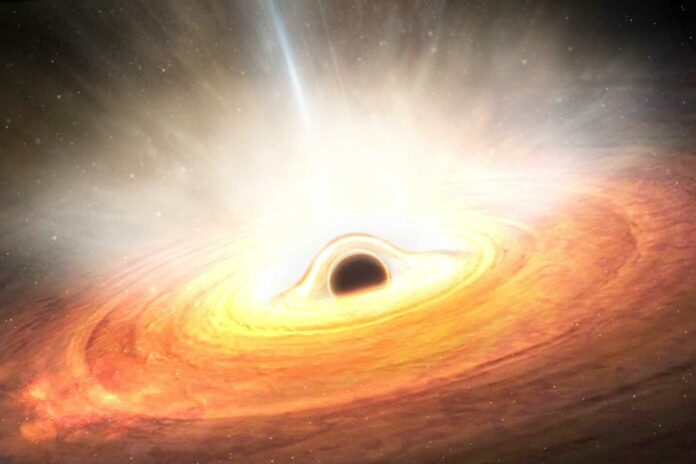Recent observations led by the University of Michigan suggest that- the European Space Agency’s X-ray telescope XMM-Newton has caught a black hole in the act of “flipping over the table” during an otherwise civilized meal. This act prevents the galaxy surrounding the black hole from forming new stars. The observations offer insights into black holes and galaxies’ co-evolution.
Every galaxy hosts a supermassive black hole at its center. The gravity of this black hole pulls the surrounding gas and bunches up in a flat accretion disc around the black hole, where it heats and lights up.
Over time, the black hole gobbles up the gas. Black holes don’t always eat up all the gas swirling around them. As they spin, they sometimes throw some of it back out into space. It’s like a messy toddler spilling food off their plate.
Sometimes, a black hole can cause a big mess by flinging out all the gas in its accretion disk at incredibly high speeds. This clears out the gas around it so fast that no new stars can form in that area. This leaves the black hole hungry, changes the galaxy’s structure, and halts star formation over a vast region.
Until now, scientists had only observed ultra-fast winds, called “black hole winds,” coming from very bright accretion discs that were gobbling up much matter. But this time, the XMM-Newton telescope detected ultra-fast winds in a pretty ordinary galaxy that was just “snacking” on matter.
In this study, scientists studied the galaxy called Markarian 817, where incredibly energetic winds are being generated.
U-M astronomer and lead author Jon Miller said, “We have observed a black hole to be flooding its host galaxy with enough gas to alter the nature of the host galaxy. We have long inferred that this must happen because galactic centers have been swept of cold gas that could form new stars and, therefore, have few new stars. Still, it has been tough to catch a black hole expelling gas with enough power to verify this key interaction. We have found an example, and it is particularly striking because the black hole doesn’t even have its throttle at max.”
U-M undergraduate researcher Miranda Zak said, “Markarian 817 stood out awfully quiet. After observing the galaxy using NASA’s Swift observatory, we found the X-ray signals faint, and I was convinced I was doing something wrong.”
Further observations using ESA’s more sensitive X-ray telescope XMM-Newton revealed what was happening. The team found the ultra-fast winds from the accretion disc blocking the X-rays emitted from the black hole’s corona.
A thorough examination of the X-ray data revealed that instead of just releasing a single burst of gas, the center of Markarian 817 produced a turbulent storm across a large area in the accretion disc. This wind lasted for hundreds of days and consisted of at least three different parts, each moving at several percent of the speed of light.
This discovery helps solve a puzzle in understanding how black holes and the galaxies around them interact. This could be explained by black hole winds that clear out the gas needed for star formation, but for this to happen, the winds need to be fast, last long enough, and be produced by black holes with typical levels of activity.
Journal Reference:
- Miranda Zak, Jon Miller et al. Fierce Feedback in an Obscured, Sub-Eddington State of the Seyfert 1.2 Markarian 817. The Astrophysical Journal Letters. DOI 10.3847/2041-8213/ad1407
